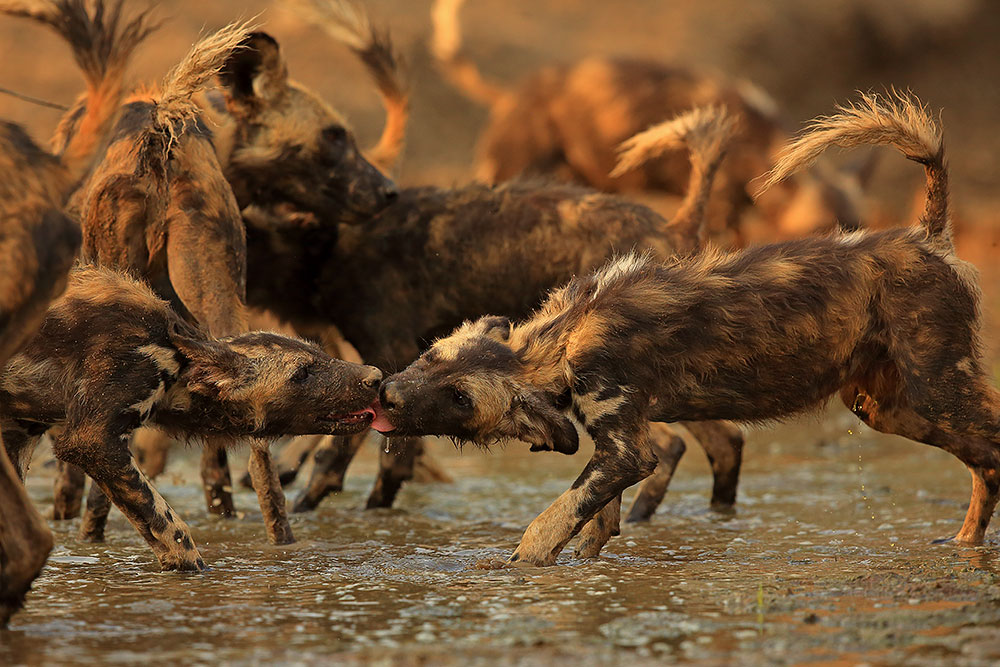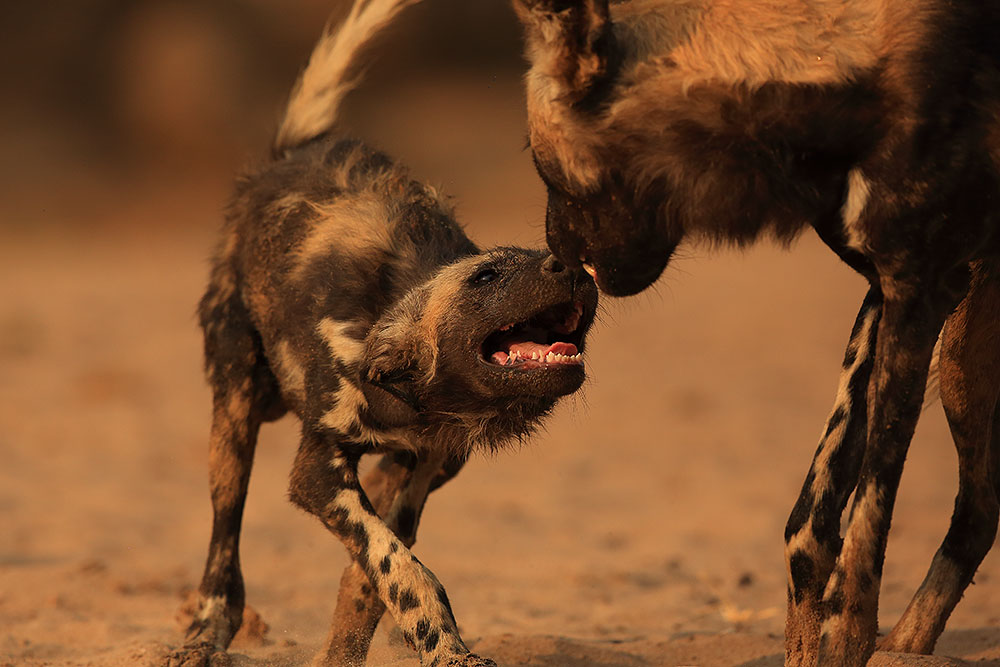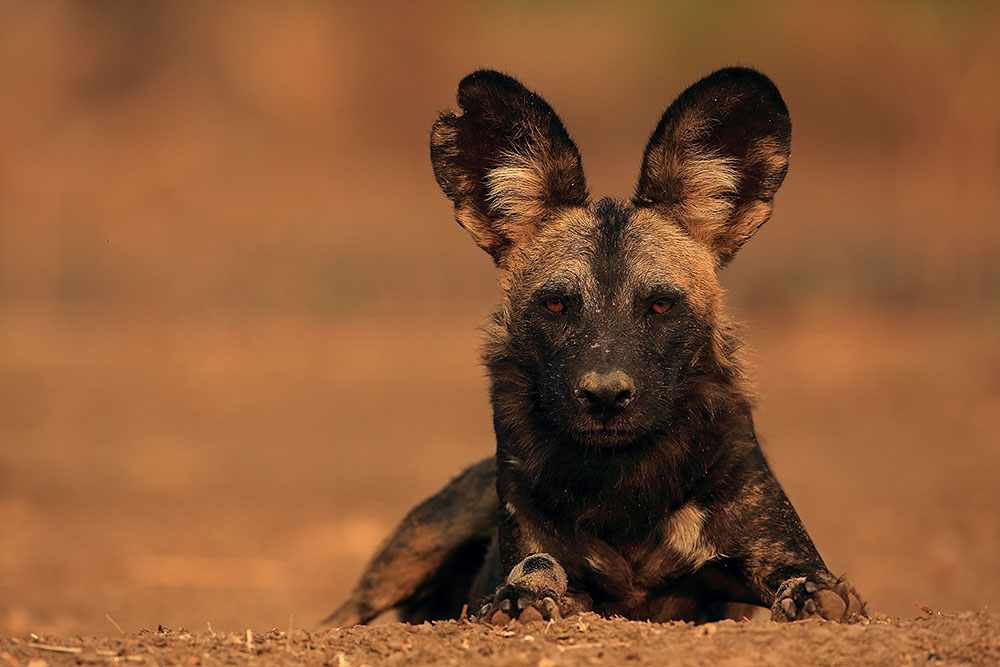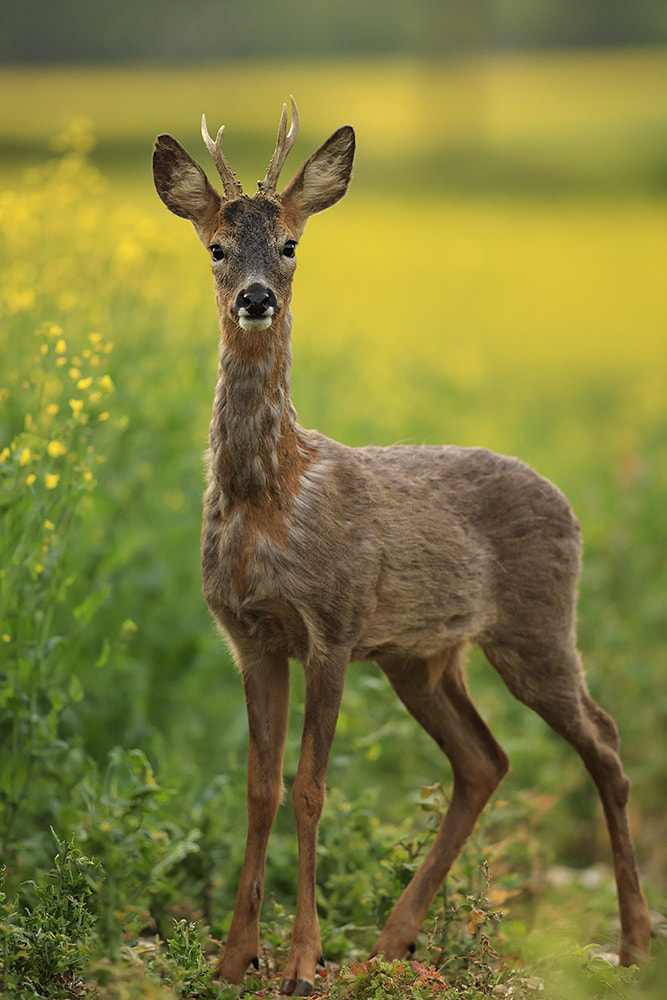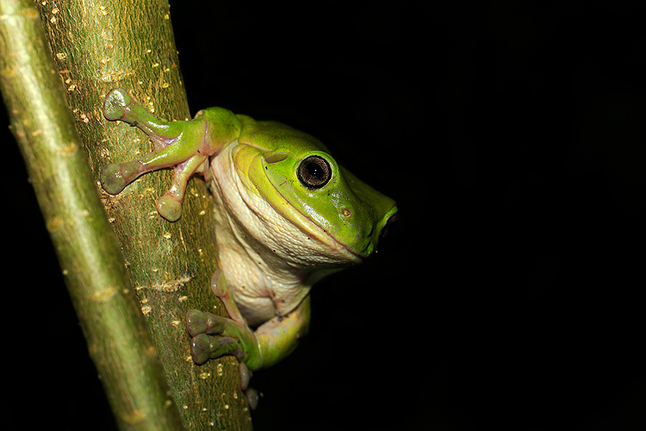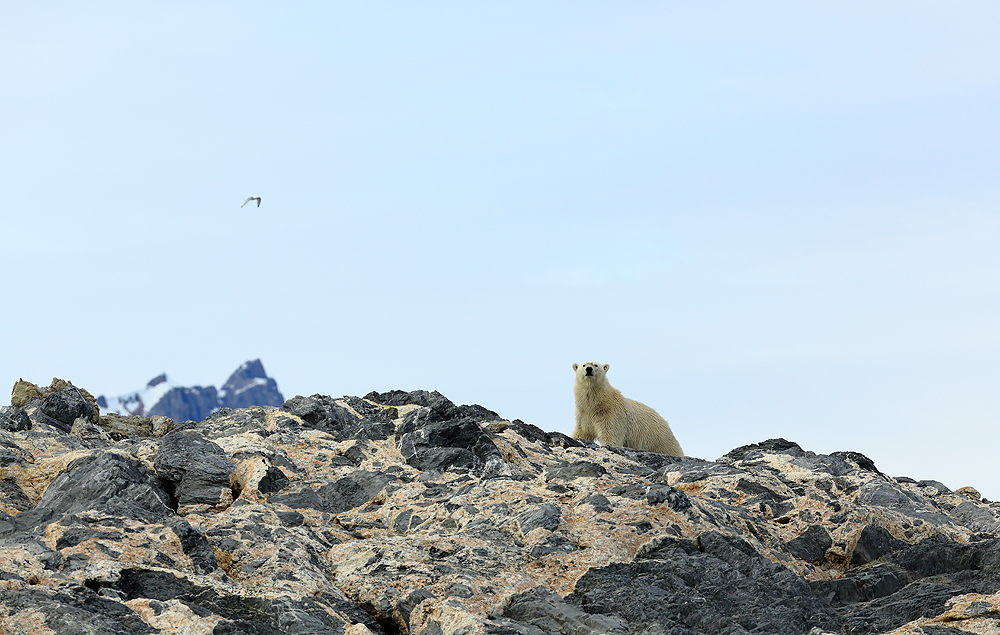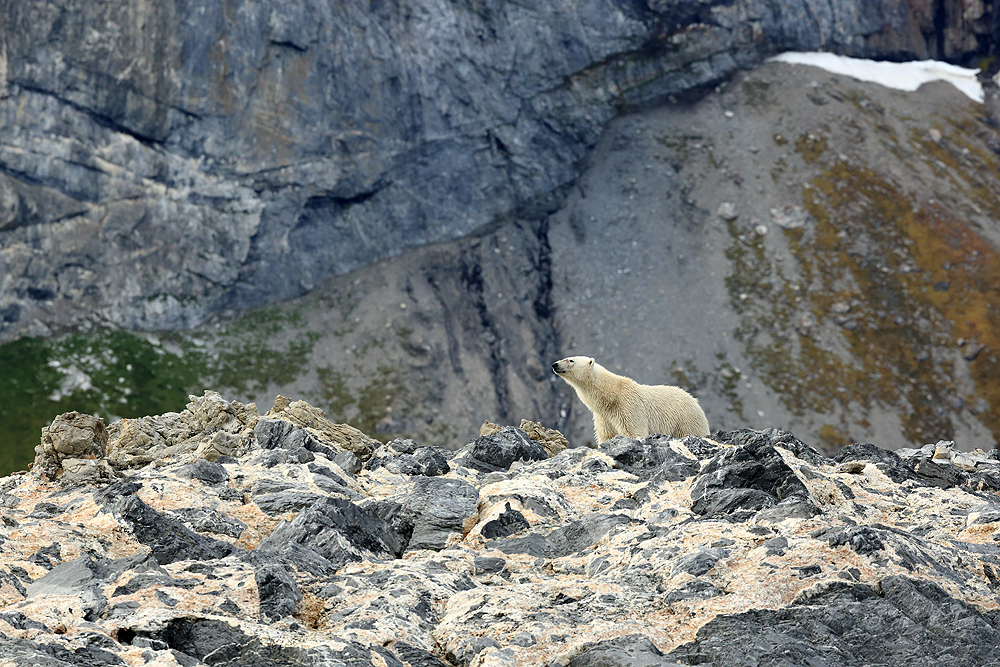|
At the end of the dry season, the heat in Mana Pools National Park just seems to build up and up. A natural crescendo, until eventually the rains come and bring a little relief. In early November though, the rains had still not arrived and day time temperatures were regularly hitting 44 degrees Celsius. Driving through the park on this particular morning, it felt like you were in the firing line of an industrial hairdryer, a stifling, warm breeze filling the air and making it feel a little uncomfortable. We were back in search of the wild dogs once more. Having spent the previous afternoon on the river, it seemed like we had to catch up with the dogs and find out what they were up to. However, no matter how hard we tried, we were unable to find the dogs on this particular morning. Instead we found a very sociable, and approachable, flock of long-tailed starlings. When a group of wildlife photographers are together, any slightly different subject just means you have something new to focus on. Later on we managed to find the small pride of lions, two adult females and a young male and spent a bit of time watching and photographing them before heading back to camp for lunch. The majority of the group decided to go out on the river once more this afternoon, all but one, who wanted to head out after the dogs once more. In order to keep the group size manageable for the canoe safari, I headed out with the one client and our guide Daryl. Well there is no other way to describe the afternoon with the dogs, other than that it was pretty magical. It was only going to be a shorter game drive/walk as we had arranged a BBQ on the banks of the Zambezi up stream of our camp. We found the dogs resting in the same drying river gulley we had left them a few days earlier. As there was only three of us, we slowly made our way towards the pack, taking our time and keeping the noise to a minimum. The whole pack were so incredibly relaxed and we were able to get extremely close. This encounter was right up there with my very best anywhere in the world, probably only coming second to coming face-to-face with the gorillas. I am not really going to say much more, other than that it was a real privilege. The following pictures and footage can do all the talking for me. If you would like to join me in October 2019, we still have a few spaces remaining. You can find out more and book your place by visiting the Wildlife Worldwide website.
0 Comments
I am really proud to work and lead trips for Wildlife Worldwide, one of the UK’s largest specialists in wildlife travel. What I particularly enjoy is that the office is set within an old barn in the charming village of Bishop’s Sutton, what’s more is we have a resident pair of barn owls.
Earlier on in the summer I spent a bit of time trying to photograph the owls. They are really easy to spot, but not so easy to photograph, particularly as there are quite a few buildings around. Anyway, here is a little taster of what I have been privileged enough to watch after finishing work in the evenings. As many of you will know, I live on the edge of the South Downs National Park. This is the UK’s newest national park, a range of stunning hills and rolling farmland, and is home to staggering number of roe deer. I have become pretty good at photographing roe deer and luckily for me, I can often see them right behind my own house. In mid-May I noticed a handsome buck as I arrived home from the office and spent around 40 minutes trying to work out my approach. The wind had been swirling and it was nearly impossible to get close enough as there was a real lack of cover. Eventually, I was able to get within 20 yards and the deer ended up approaching me – the perfect scenario. To start with the male deer was actually too close to photograph, his inquisitive nature meant he approached to within only a few yards. I stayed perfectly still, the deer alert to my presence watched me, but never tried to run. It slowly moved away and into the dense crop of oilseed. As you can see, I was blessed with a very cooperative buck, standing beautifully in the yellow flowers of the oilseed crop. It wasn't the longest photography session, as the deer decided to slowly move away into the deepest part of the field, but I managed to capture some beautiful imagery in the short time I was there.
All of the images were taken on my 500mm lens, which is usually perfect for photographing roe deer. So we have spent the last few weeks up in the tropical part of Queensland, hot sun, rain and frogs were the recurring theme. Some people hate frogs and some are even afraid of them but I absolutely love them, especially tree frogs, and went out almost every evening in search of some amphibian friends. To say I got lucky would be an an understatement. It was utterly mind blowing! There was the world's largest species of tree frog, the White-lipped Tree Frog that really would fill your entire hand, as well as the tiny little Red-eyed Tree Frog which are indescribably beautiful and rather petite compared to their larger cousins. Anyway, I had an absolutely amazing time with the frogs and the following images were captured over the space of a few weeks. We have already encountered the Green Tree Frog further south near to Byron Bay but they are still amazing subjects and they always look like they are smiling. In my books, any animal that looks as if it is smiling is instantly a favourite. At first glance the Dainty and the Red-eyed Tree Frogs look very similar but their calls are noticeably different. Once you get close enough with a torch you quickly realise they have quite different features and own distinct habits. They are much more aware of you when photographing them and only relax again once you move further away. The Eastern Dwarf Tree Frog really is utterly tiny, at first you think it must be a new born. To give you an idea of its miniature stature, the tadpoles are actually bigger then some of the adult frogs. The image below gives you an idea of just how tiny they are, resting on my girlfriend's finger tip (this individual was being rescued from the swimming pool). I will update you all with some amazing mammal pictures soon, including one that I have always wanted to see, a really weird and unique species. I would also just like to say a massive thank you to Canon Professional Services, Australia! My Canon 5D mkIII had a complete power unit failure and I was stuck without a camera but CPS came to my rescue and lent me a 1DX for the Christmas period. Without this camera I would not have been able to capture any of the images you see above. This just underlines why I use Canon equipment, the service is out of this world.
This morning we awoke to big blue skies and headed into the spectacularly beautiful Hornsund. This massive fjord is surrounded by dramatic mountain peaks and destructive glaciers. Being so far South, I have to admit I really wasn't expecting to see as much of the truly specialist Arctic wildlife. Upon arrival in this stunning setting a female Polar Bear was spotted on the shoreline and then moments later another larger bear was spotted on the far shore (perhaps a male). We would be going on a Zodiac cruise to see if we could get any closer to the bears and then on to explore the fjord ... little did we know what was in store for us all. We all met on the deck and waited to board our Zodiacs for our afternoon cruise, I was with the Naturetrek leader Peter Dunn and expedition leader Jan Belgers. We set off as one of the lead boats and headed toward the small headland where we had earlier sighted the female bear. As we approached the shore line we realised that the bear had moved on and as much as we were scanning both the water and the shore we were unable to see anything. Peter then spotted some movement on the water's surface way out in the fjord ... it was the bear, it had managed to slip by us in the ice-cold water. The bear approached an island and we all held our breaths as we prayed the bear would be a 'quality' bear. It was definitely a 'quality' bear ... The real benefit of the island was that the bear felt completely at ease and we could travel all the way round for a constantly changing backdrop. As a photographer you always want to try and capture that image that stands out and lingers in the mind, this really was the perfect photographic opportunity. Even then this was one of those moments where you just have to put the camera down and really take in the moment! We slowly moved around the island the backdrop was more than you could ever have dreamt of. We slowly moved closer and closer, all the time keeping an eye on the bear to make sure it was completely at ease. We all go the odd glance and a quick sniff but it certainly wasn't affecting its scavenging behaviour. The bear was obviously search for whatever food it could find, it is known that a variety of birds breed on this island in the summer months. After a wonderful hour with this remarkable Polar Bear we thought it would be best to leave it in peace and leave it to carry on with its search for food. With a few months remaining until the sea ice returns this bear will really have to try and conserve its energy and find whatever scraps that are available. We move further up the fjord to see whether we could approach the second bear, he was a huge male but he was not at ll interested in us and remained in his slumber. We carried on towards the head of a glacier to explore the amazing landscapes and the ice-filled water. I really hope you have enjoyed looking through all of these images and with only one more post left, I think that this is perhaps the highlight of the cruise. This day was quite possibly the most memorable of my life outside of my time in Africa, with jaw-dropping landscapes, danger and unbeatable wildlife encounters I am not sure what can beat it.
Coming up are some charismatic reindeer and a few more landscapes so please keep on reading. |
AuthorBret Charman Archives
July 2024
Categories
All
|







